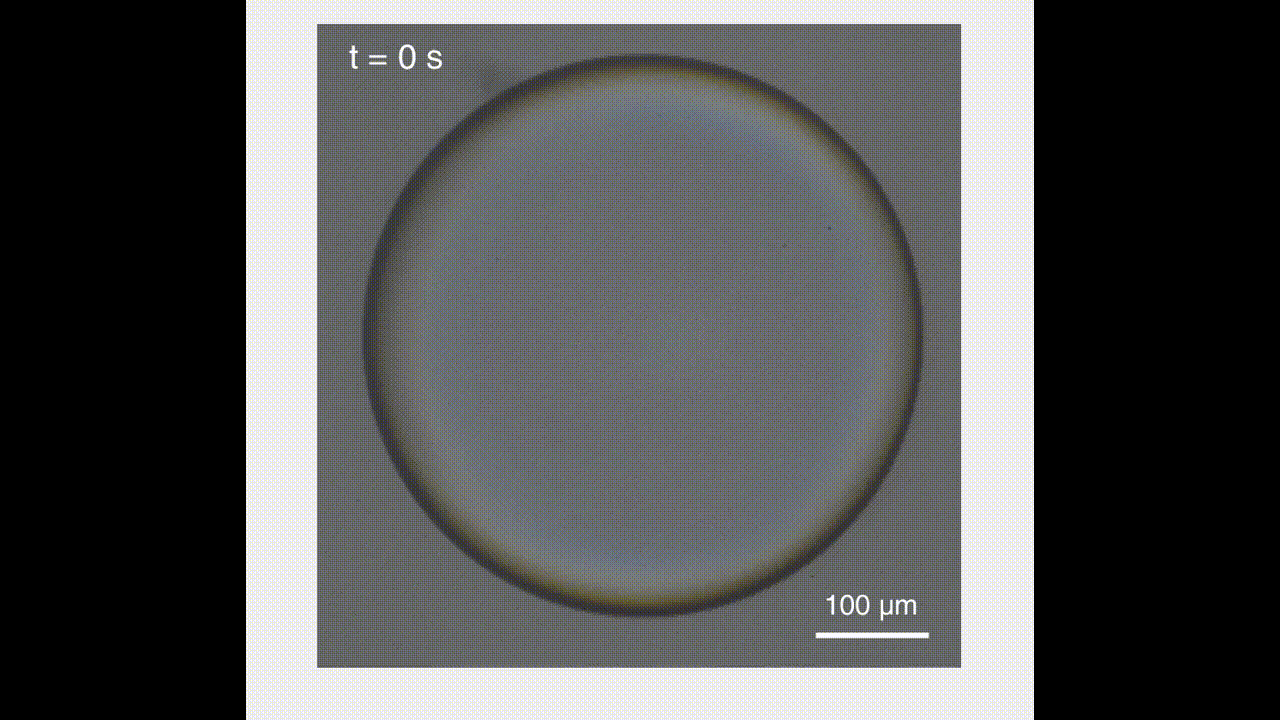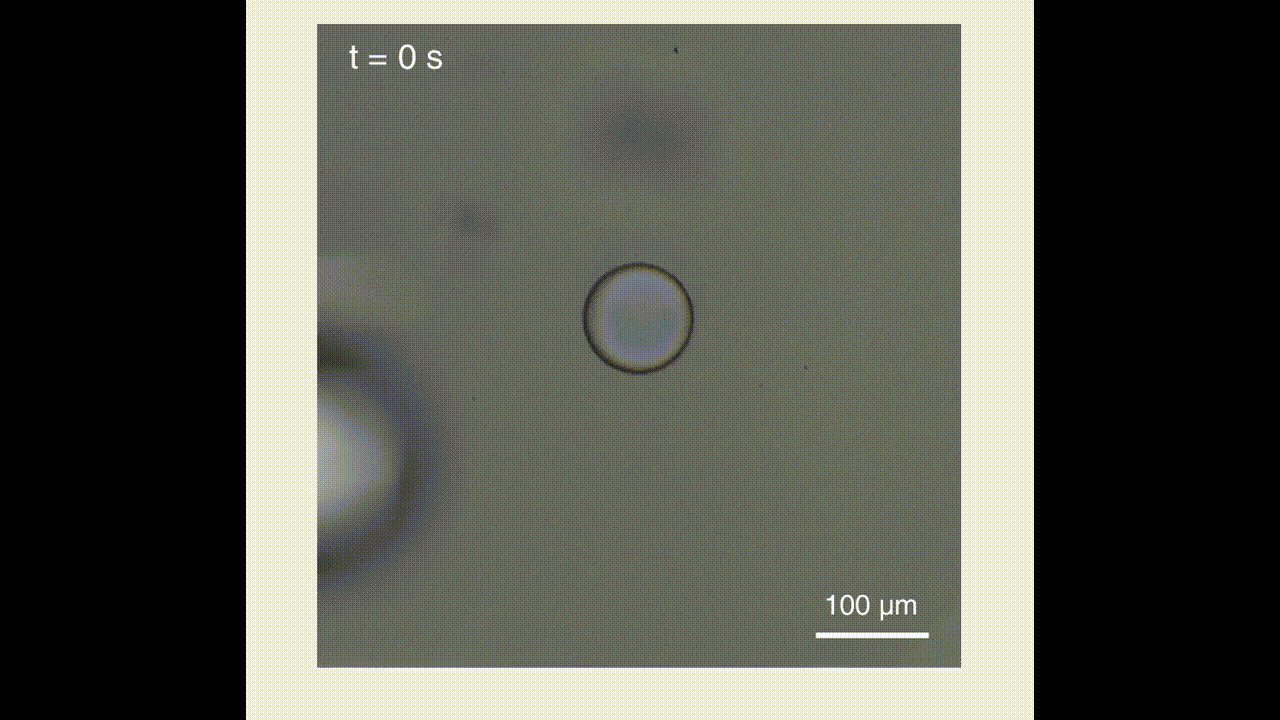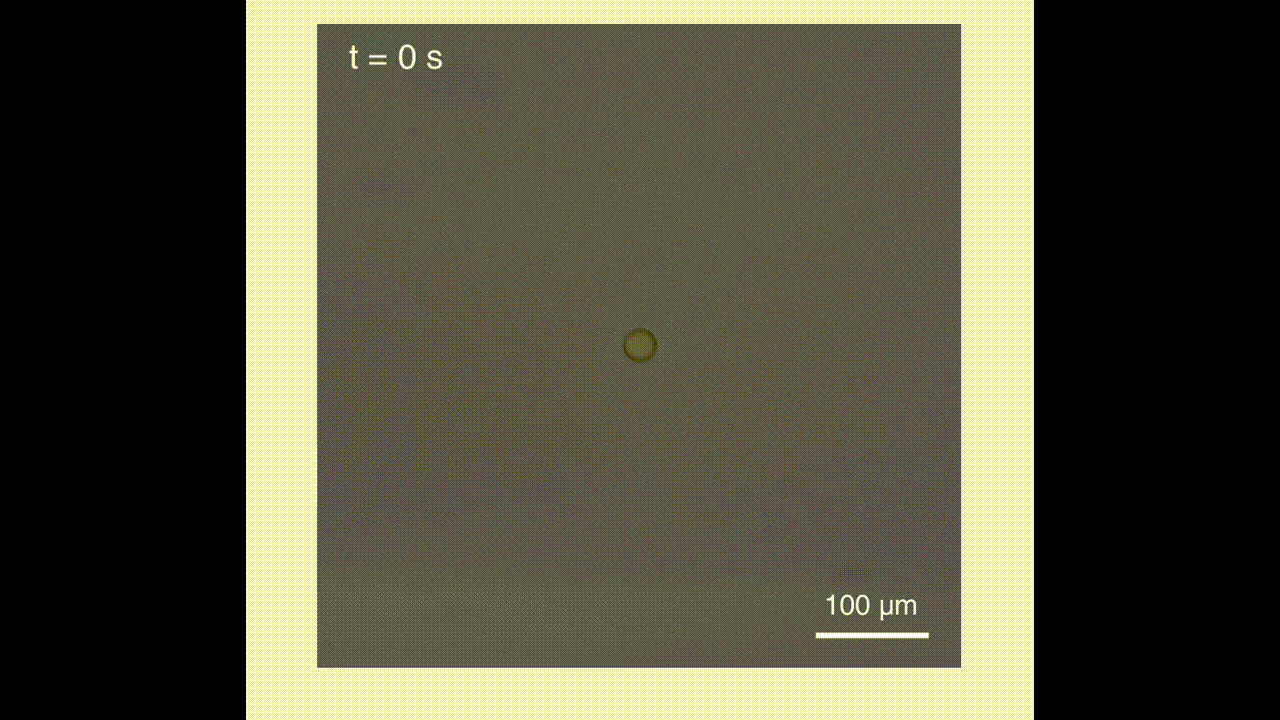Interfacial Phenomena
An interface of liquid is omnipresent in nature, life, and industry. We focus on surface tension dominant problems including 1) Marangoni effects, 2) wetting and dewetting, 3) interfacial instabilities, and 4) crystallization by evaporation. We utilize various direct optical measurement techniques, for instance 2D/3D Particle Image Velocimetry, interferometric analysis, Schlieren method, and high-speed and fluorescent imaging, to study these problems.
Complex membrane formation using surfactant-regulated Marangoni instability at immiscible liquid-liquid interface

Soft matter has burgeoned in various areas including chemical and bio-engineering, fluid mechanics, and material sciences. Among them, self-assembling mechanism and capillary origami have received great attention. The conventional capillary origami self-assembly is limited to the predetermined original shape of the sheet, i.e., passive capillary origami. In this study, we introduce crystal capillary origami, which will open the new era of active capillary origami in soft matters. This method enables to fabricate a spherical capsule. We show that salt crystal accretion yields a spherical capsule composed of self-assembled nanostructures. The crystallization is triggered at the interface of salts-saturated water-in-oil (W/O) emulsions by diffusion. We control the crystal capillary origami effect to make the three- dimensional enclosed geometry by varying the Laplace pressure of the emulsion.
Related publication:S.-J Park, M.-S. Lee, M. E. Kilic, J. Ryu, H. Park, Y. I. Park, H. Kim, K.-R. Lee, J.-H. Lee, "Autonomous Interfacial Assembly of Polymer Nanofilms via Surfactant-Regulated Marangoni Instability," Nano Lett. (2023)
Characterization of interfacial properties of liquid metal


The morphology and surface energy of gallium-based liquid metal (LM) droplets are influenced by the oxygen solubility (xg) of the surrounding liquid. Using a high-speed camera, we captured the pinch-off frames of macroscopic LM droplets in various solvents. The eccentricity of droplets increased sigmoidally with the xg of the ambient liquid. Anisotropic pear-shaped LM droplets were observed in high-xg liquids, concomitantly with surface oxidation. To explore small-scale features, we additionally fabricated micro/nanoscale LM droplets via ultrasonication in organic solvent environments and subsequent evaporation of the solvent. Carbon/Oxygen and Carbon/Gallium atomic ratios of LM microdroplets increased with the solvent’s xg, indicating that oxygen and organic solvent molecules interacted sequentially with LM. The van Oss-Good model was further implemented to determine the polar and nonpolar surface energy components of LM layers with adsorbates. While the polar component made a minor contribution to the total surface energy, the nonpolar component displayed a strong logarithmic relationship with the xg of the solvent used to treat the LM layer.
Related publication:
G. Ryu, K. Park, and H. Kim, "Interfacial properties of liquid metal immersed in various liquids," J Colloid Interf. Sci. 621, 285-294

Capillary origami self-assembly


Soft matter has burgeoned in various areas including chemical and bio-engineering, fluid mechanics, and material sciences. Among them, self-assembling mechanism and capillary origami have received great attention. The conventional capillary origami self-assembly is limited to the predetermined original shape of the sheet, i.e., passive capillary origami. In this study, we introduce crystal capillary origami, which will open the new era of active capillary origami in soft matters. This method enables to fabricate a spherical capsule. We show that salt crystal accretion yields a spherical capsule composed of self-assembled nanostructures. The crystallization is triggered at the interface of salts-saturated water-in-oil (W/O) emulsions by diffusion. We control the crystal capillary origami effect to make the three- dimensional enclosed geometry by varying the Laplace pressure of the emulsion.
Related publication:
K. Park and H. Kim, "Crystal capillary origami capsule with self-assembled nanostructures," Nanoscale 13(35), 14656-14665 (2021)


Mixing enhancement using solutal Marangoni flows
Soft matter has burgeoned in various areas including chemical and bio-engineering, fluid mechanics, and material sciences. Among them, self-assembling mechanism and capillary origami have received great attention. The conventional capillary origami self-assembly is limited to the predetermined original shape of the sheet, i.e., passive capillary origami. In this study, we introduce crystal capillary origami, which will open the new era of active capillary origami in soft matters. This method enables to fabricate a spherical capsule. We show that salt crystal accretion yields a spherical capsule composed of self-assembled nanostructures. The crystallization is triggered at the interface of salts-saturated water-in-oil (W/O) emulsions by diffusion. We control the crystal capillary origami effect to make the three- dimensional enclosed geometry by varying the Laplace pressure of the emulsion.
Related publication:
Park J; Ryu J; Sung HJ; and Kim H, "Control of solutal Marangoni-driven vortical flows and enhancement of mixing efficiency," accepted, JOURNAL OF COLLOID AND INTERFACE SCIENCE (IF: 6.361)
Solutal-driven Marangoni instability between fully miscible fluids
Mixing and spreading of different liquids are omnipresent in nature, life, and technology, such as oil pollution on the sea, estuaries, food processing, the cosmetic and beverage industries, lab-on-a-chip, and polymer processing. Where different liquids, having different physical properties including surface tensions and viscosities, meet Marangoni and other physico-chemical hydrodynamic phenomena are important. However, the mixing and spread- ing mechanisms for miscible liquids remain poorly characterized. We observed that a deposited soluble liquid drop on a liquid surface remains as a static lens without immediately spreading and mixing, which is a counterintuitive result, when two liquids have different surface tensions. Simultaneously, a convective flow is generated, which is referred as interfacial turbulence corresponding to ‘Marangoni instability’. Once the liquids near the interface are completely mixed, the Marangoni flows stop. We develop a theoretical model to predict the finite spreading time and length scales and Marangoni-driven convection flow speed. The fundamental understanding on this solutal-Marangoni flow enables driving bulk flows and constructing an effective drug delivery and surface cleaning material without surface contamination by immiscible chemical species.
Related publication:
H. Kim, K. Muller, O. Shardt, S. Afkhami, H.A. Stone, "Solutal-Marangoni flows of miscible liquids drive transport without surface contamination," accepted in Nature Physics.
H. Kim, J. Lee J, T-H Kim, and H-Y Kim, "Spontaneous Marangoni mixing of miscible liquids at a liquid-liquid-air interface," Langmuir 31(31), 8726 (2014)
Solutal Marangoni instability creates vortex mixing flows
We perform a quantitative analysis of a spontaneous vortex caused by Marangoni effects. When a drop of volatile liquid with a lower surface tension than that of water is deposited on a free water surface, it creates surface tension gradients leading to a Marangoni vortex at the contact line, i.e. liquid-liquid-air contact point. We report that the vorticity sign is determined by the gradient of surface tension between two liquids and the vortex strength is mainly proportional to the Marangoni force. Based on energy conservation, we develop an analytical solution to estimate the vortex strength. This figure can show one of the Marangoni effect examples.
Related publication:
H. Kim, J. Lee J, T-H Kim, and H-Y Kim, "Spontaneous Marangoni mixing of miscible liquids at a liquid-liquid-air interface," Langmuir 31(31), 8726 (2014)
Preventing thin film rupture using Marangoni effects
The movie presents the self-healing behavior by the surface tension difference between the film and the droplet. The DI water droplet falls toward the soap film having a relatively low surface tension. If the droplet inertia is large enough compared to the surface energy of the soap film, after the droplet contacts the thin film, the film deforms and drags by the water droplet penetration by the gravity effect. However, the thin film can not be ruptured by the impact because the Marangoni effect retracts the soap film to the center of the impact location. Then, the droplet can pass the film without the rupture and the soap film can be healed. This move is taken with a high-speed camera (Phantom V7.3) @9900 fps.
Relevant literatures:
L. Courbin and H.A. Howard, "Impact, puncturing, and the self-healing of soap films," Phys. Fluids 18.9, 91105 (2006)
T. Gilet and J. Bush, "The fluid trampoline: droplets bouncing on a soap film," J. Fluid Mech. 625, 167 (2009)
Suppressing Rayleigh-Taylor instabilities using curvature
The dynamics of a thin liquid film on the underside of a curved cylindrical substrate is studied. The evolution of the liquid layer is investigated as the film thickness and the radius of curvature of the substrate are varied. A dimensionless parameter (a modified Bond number) that incorporates both geometric parameters, gravity, and surface tension is identified, and allows the observations to be classified according to three different flow regimes: stable films, films with transient growth of perturbations followed by decay, and unstable films. Experiments and linear stability theory confirm that, below a critical value the Bond number, curvature of the substrate suppresses the Rayleigh-Taylor instability.
Related publication:
P. Trinh*, H. Kim*, P.D. Howell, S.J. Chapman, and H.A. Stone, "Curvature suppresses the Rayleigh-Taylor instability," Phys. Fluids 26, 051704 (2014) *Equivalent 1st co-author.
Controlling Saffman-Taylor instabilities using lifting mechanism

Control and stabilization of viscous fingering of immiscible fluids impacts a wide variety of pressure-driven multiphase flows. We report theoretical and experimental results on time-dependent control strategy by manipulating the gap thickness b(t) in a lifting Hele-Shaw cell in the power-law form b(t) ~ t^1/7. Experimental results show good quantitative agreement with the predictions of linear stability analysis. By choosing the value of a single time-independent control parameter we can either totally suppress the viscous fingering instability or maintain a series of non-splitting viscous fingers during the fluid displacement process. Besides the gap thickness of a Hele-Shaw cell, in principle, time-dependent control strategies can also be placed on the injection rate, viscosity of the displaced fluid, and interfacial tension between the two fluids.
Related publication:
Z. Zheng*, H. Kim*, and H.A. Stone, "Controlling viscous fingering using time-dependent strategies," Phys. Rev. Lett. 115, 174501 (2015) *Equivalent 1st co-author.
Controlling liquid imbibition patterns in a porous medium

We present that a liquid propagation shape in a thin porous medium is manipulated by varying injection volume flow rates. The shape appears a circle, octagon, and square. The time evolution of the liquid propagation presents a power-law behavior t^(1/2). To predict the shape, we find the critical shape parameter scaled with the ratio between capillary forces and forces from injection. Additionally, we present that the propagation patterns of the liquid interface can be controlled by the coherence or relative orientation of multiple porous layers.

